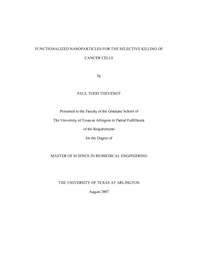
ATTENTION: The works hosted here are being migrated to a new repository that will consolidate resources, improve discoverability, and better show UTA's research impact on the global community. We will update authors as the migration progresses. Please see MavMatrix for more information.
Show simple item record
| dc.contributor.author | Thevenot, Paul Todd | en_US |
| dc.date.accessioned | 2007-09-17T17:07:34Z | |
| dc.date.available | 2007-09-17T17:07:34Z | |
| dc.date.issued | 2007-09-17T17:07:34Z | |
| dc.date.submitted | July 2007 | en_US |
| dc.identifier.other | DISS-1821 | en_US |
| dc.identifier.uri | http://hdl.handle.net/10106/613 | |
| dc.description.abstract | The use of nanoparticles for cancer imaging and drug delivery has produced some success in improving the efficacy and safety of cancer chemotherapy. It is generally believed that the efficiency of nanoparticle-based cancer therapy would be greatly improved if such particles could be designed to directly interact with and eradicate tumor. Many recent studies have revealed that surface functionality plays an important role in particle:cell interactions. Using titanium dioxide (TiO2) nanoparticles (21 nm diameter) as test subjects, nanoparticles with different functional groups, hydroxyl (-OH), amine (-NH2), and carboxyl (-COOH) were produced and used in this investigation. An in vitro cell culture system was used to evaluate the interaction of a series of surface functionalized TiO2 nanoparticles with a number of normal animal and cancer cell lines, including B16F10 melanoma, Lewis lung carcinoma (LLC), JHU v prostate cancer cells, and 3T3 fibroblasts. It was observed that cell viability following exposure to TiO2 nanoparticles was dependent on particle concentration, cell line, and TiO2 surface chemistry. Overall, the TiO2 nanoparticles, both functionalized and uncoated, exerted the strongest toxicity effects on LLC cells and least toxicity on B16F10 cells and 3T3 fibroblasts. Cell viability was observed to depend on the specific surface chemistry of the particles. In general, particles with -NH2 or -OH functional groups exhibited significantly higher toxicity than those functionalized with -COOH groups. Microscopy analysis of cell viability as well as spectophotometric analysis of lactate dehydrogenase (LDH) content and arrays of cell proliferation indicated that the TiO2 nanoparticles disrupt the cell membrane integrity leading to cell death. Overall, the present results suggest that functionalized TiO2 nanoparticles, and presumably other nanoparticles similarly surface modified, may be engineered specifically for targeted cancer therapy. The ability to fully understand how a precisely chemically defined surface interacts with both cell monolayers and body tissues will help scientists and engineers in the design of materials that will perform their desired function while also minimizing unfavorable interactions within the body. vi | en_US |
| dc.description.sponsorship | Tang, Liping | en_US |
| dc.language.iso | EN | en_US |
| dc.publisher | Biomedical Engineering | en_US |
| dc.title | Functionalized Nanoparticles For The Selective Killing Of Cancer Cells | en_US |
| dc.type | M.S.E. | en_US |
| dc.contributor.committeeChair | Tang, Liping | en_US |
| dc.degree.department | Biomedical Engineering | en_US |
| dc.degree.discipline | Biomedical Engineering | en_US |
| dc.degree.grantor | University of Texas at Arlington | en_US |
| dc.degree.level | masters | en_US |
| dc.degree.name | M.S.E. | en_US |
| dc.identifier.externalLink | https://www.uta.edu/ra/real/editprofile.php?onlyview=1&pid=58 | |
| dc.identifier.externalLinkDescription | Link to Research Profiles | |
Files in this item
- Name:
- umi-uta-1821.pdf
- Size:
- 523.8Kb
- Format:
- PDF
This item appears in the following Collection(s)
Show simple item record


